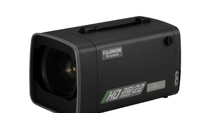Deep-sea remote captures HD footage of undersea volcano eruption

The Advanced Imaging and Visualization Laboratory (AIVL) at the Woods Hole Oceanographic Institution (WHOI) has captured the first video and still images of a deep-sea volcano actively erupting molten lava on the seafloor using a prototype still and HD video camera equipped with a Fujinon HA13x4.5 wide-angle Premier Series HD zoom lens.
During a May 2009 research expedition aboard the RV Thomas Thompson, oceanographers from the National Oceanic and Atmospheric Administration (NOAA) usedJason, a remotely operated vehicle (ROV) that is part of the National Deep Submergence Facility operated by WHOI, to observe and record the powerful event, which occurred in the South Pacific almost 4000ft below the ocean surface. The HD video footage was shown for the first time in December 2009 at the American Geophysical Union fall meeting in San Francisco.
A team of scientists led by Joe Resing, a chemical oceanographer at the University of Washington and NOAA, used the Jason ROV, which was positioned close to the erupting volcano to collect samples of rocks, water and biological specimens. “We were lucky to have those cameras on the vehicle. They are important to the science,” said Tim Shank, a WHOI macrobiologist who operated the camera system with Maryann Keith. “We use the HD cameras to try to identify species. They allow us to look at the morphology of the animals, some smaller than three or four inches long.”
The camera system was designed and operated by AIVL, which develops high-resolution imaging systems for scientific and entertainment imaging applications. Footage from AIVL systems has been used in hundreds of TV programs and documentaries as well as IMAX films.
According to AIVL research specialist William Lange, the camera’s single-CCD image sensor acquires up to 60 still images per second while simultaneously generating HD video at 29.97fps. The system delivers 1920 x 1080 resolution, producing raw still image data without spatial compression and a 10-bit, 4:2:2 HD-SDI video stream.
The ROV transmitted live HD video of the eruption to the RV Thomas Thompson through a fiber-optic tether. The system’s Fujinon HD lens provided almost twice the focal length and many times the resolution of the SD cameras that are normally used on vehicles like Jason, Lange said. “This camera is a hybrid based around the concept that we need to acquire still and motion imagery from our HD cameras,” he said. “It’s an architecture we’ve developed to support a variety of image sensors, and its modularity allows us to adapt it efficiently for different scientific purposes.”
The National Science Foundation funded the installation of the prototype camera system, which had been used on two previous expeditions. After its successful tests, Lange said the new camera could become a permanent upgrade on Jason and Alvin, a manned deep-sea submersible, later this year.
The professional video industry's #1 source for news, trends and product and tech information. Sign up below.
